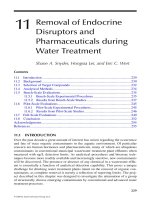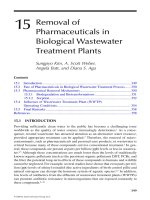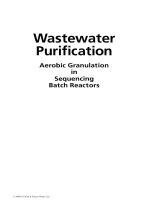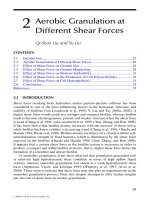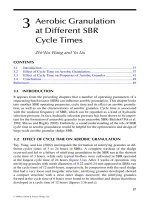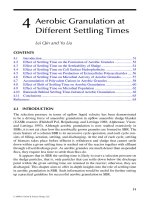Wastewater Purification: Aerobic Granulation in Sequencing Batch Reactors - Chapter 10 doc
Bạn đang xem bản rút gọn của tài liệu. Xem và tải ngay bản đầy đủ của tài liệu tại đây (424.81 KB, 14 trang )
181
10
Essential Roles of
Extracellular Polymeric
Substances in Aerobic
Granulation
Yu Liu and Zhi-Wu Wang
CONTENTS
10.1 Introduction 181
10.2 Main Composition of EPS in Aerobic Granules 181
10.3 Major Factors Inuencing EPS Production In Aerobic Granules 183
10.4 The Role of EPS in Aerobic Granulation 185
10.5 EPS-Enhanced Stability of Aerobic Granules 187
10.6 Conclusions 191
References 191
10.1 INTRODUCTION
Extracellular polymeric substances (EPS) are sticky materials secreted by cells; extra-
cellular polysaccharides (PS) are the important component of EPS and are highly
involved in the formation of matrix structure and improvement of long-term stability
of aerobic granules, as discussed in the preceding chapters. It is thought that EPS
actasaneffectivebiogluetocross-linkbacteriaintoanaerobicgranule (gure10.1),
and the EPS matrix of the aerobic granule can protect bacteria from harsh environ-
mentalconditions.InviewoftheimportanceofPS,thischapterattemptstoprovide
adeeperinsightintothefunctionsofEPSinaerobicgranulation.
10.2 MAIN COMPOSITION OF EPS IN AEROBIC GRANULES
EPShavebeendetectedinsignicantquantitiesinbothaerobicandanaerobicgran-
ules,andtheyformathree-dimensionalmatrixinwhichbacteriaandotherparticles
are embedded. EPS are produced by microorganisms themselves during cultivation,
whichareadvantageousinmanyrespectsfortheirsurvivalinvariouscircumstances.
Intermsofmicrobiology,EPScanhelpstabilizemembranestructureandalsomay
serveasaprotectivebarrier(Prescott,Harley,andKlein1999).EPSproducedin
biogranules contain variable proportions of proteins, polysaccharides, nucleic acids,
humics-likesubstances,lipids,andheteropolymers-likeglycoprotein(Goodwinand
53671_C010.indd 181 10/29/07 7:32:41 AM
© 2008 by Taylor & Francis Group, LLC
© 2008 by Taylor & Francis Group, LLC
182 Wastewater Purification
Forster1985;HoranandEccles1986;Grotenhuisetal.1991;Urbain,Block,and
Manem1993;Jorandetal.1995;Frolundetal.1996).Itshouldbepointedoutthat
polysaccharides are the only component that are synthesized extracellularly for a
specic function with neutral and acidic polysaccharides, while proteins, lipids, and
nucleic acids can exist in the extracellular polymer network due to the excretion of
intracellularpolymersorasaresultofcelllysis(DurmazandSanin2001;Mahmoud
etal.2003).EPShasbeenfoundinalmostallformsofmicrobialaggregates,includ
-
ing bioocs, biolm, anaerobic and aerobic granules. However, the content of EPS
inaerobicgranuleswasfoundtobemuchhigherthanthoseinconventionalbioocs
andbiolms(Tay,Liu,andLiu2001c).
In the environmental engineering literature, there are contradictory reports
onthecompositionofEPSinbiogranules,especiallytheratioofcarbohydratesto
proteins.ProteinshavebeenreportedtobethepredominantcomponentofEPSin
anaerobic granules (Fukuzaki, Nishio, and Nagai 1995), while other evidence shows
that EPS were mainly composed of carbohydrates (Fang 2000). It seems that the
quantity and the composition of EPS produced by bacteria depend on a number
of factors, such as microbial species, the growth phase of the strain, the type of
limiting substrate (carbon, nitrogen, and phosphorous), oxygen limitation, ionic
strength,culturetemperature,shearforceandsoon(Nielsen,Jahn,andPalmgren
1997;Tay,Liu,andLiu2001a;Nicholsetal.2004;Qinetal.2004).Forexample,the
totalamountofEPSandtheircompositionintermsoftheratioofcarbohydratesto
proteins were inuenced by the magnitude of carbon and nitrogen sources (Sheng,
Yu,andYue2006).Thismayimplythatthecompositionofextracellularpolymers
varies and is related to microbial species, the physiological state of bacteria, and
operatingconditionsunderwhichbiogranulesaredeveloped.Infact,ashiftinbac
-
terialspeciesduringbiogranulationhasbeenreported,andsuchamicrobialshift
wouldaffecttheproductionandcompositionofEPS(Etchebehereetal.2003;Yiet
al.2003).ItappearsthattheincomparableEPSresultsreportedintheliteratureresult
partiallyfromthecomplexityofamixedmicrobialcultureunderdifferentoperation
conditions. Another point that needs to be addressed is that the EPS mainly include
boundandsolublepolymers,theratiobetweenwhichmaychangesubstantiallyeven
withinthesamespeciesundervariousgrowthconditions.Thesolublepolymerscan
Individual bacterium
Polymeric chain of EPS
Bridging
FIGURE 10.1 A schematic interpretation of extracellular polysaccharides in aerobic
granulation.
53671_C010.indd 182 10/29/07 7:32:42 AM
© 2008 by Taylor & Francis Group, LLC
© 2008 by Taylor & Francis Group, LLC
Essential Roles of Extracellular Polymeric Substances in Aerobic Granulation 183
be transferred to the supernatant after centrifugation, while the bound polymers are
still tightly attached to cells and cannot be recovered from the supernatant (Nielsen,
Jahn, and Palmgren 1997).
Zhang, Bishop, and Kinkle (1999) compared different EPS extraction methods
for a biolm sample, including the regular centrifugation, ethylenediamine tetraace
-
tic acid (EDTA) extraction, ultracentrifugation, steaming extraction, and regular
centrifugation with formaldehyde (RCF), and found that the RCF method gave the
highest yield ratio of carbohydrates to proteins of 13.7 for the aerobic/sulfate reduc
-
ingbiolmsandtheothermethodsgavearangeofratiosof1.54to2.23.Thisis
indeedconsistentwiththendingbyAzeredo,Lazarova,andOliveira(1999)that
manyEPSextractionmethodsdevelopedforbiolmswerenotefcient,andsome
-
howcouldpromoteleakageofintracellularmaterials.Sheng,Yu,andYu(2005a)also
compared four extraction methods (EDTA, NaOH, H
2
SO
4
, heating-centrifugation)
ofEPSproducedfromaphotosyntheticbacterium,
Rhodopseudomonas acidophila,
and they concluded that the EDTA extraction method was the most effective over
theothers.Areviewbasedonover200publicationsrelatedtoEPSinactivated
sludge reveals that reported composition and quantity of EPS strongly depend on the
extractionmethodsemployed(LiuandFang2003).Althoughanumberofphysical
andchemicalmethods,forexample,high-speedcentrifugation,boilingtreatmentin
acidoralkali,andutilizationofsolventextractionorcationexchangeresinsarecur
-
rentlyavailableforextractingEPSfrombiogranules,noneofthemhasbeenadopted
as a standard procedure yet. In addition to the effect of microbial species, the use of
nonstandardized procedures causes incomparability of the EPS results available in
the present literature.
10.3 MAJOR FACTORS INFLUENCING EPS PRODUCTION IN
AEROBIC GRANULES
There is no need for microorganisms to secrete excessive EPS under normal culture
conditions.TheobservedenhancedproductionofEPSinbiogranulesisinducedby
someso-calledstressfulcultureconditions(Nicholsetal.2004;Qinetal.2004).So
far, it has been understood that a number of operating parameters, including reactor
type, substrate composition, substrate loading rate, hydraulic retention time, hydro
-
dynamic shear force, settling time in sequencing batch reactors (SBRs), feast-famine
regimeninSBRs,culturetemperature,etc.,maystimulatebacteriatosecretemore
EPS.ThecompositionofEPSisalsorelatedtothecharacteristicsofthefeedwaste
-
water,forexampleEPSinanaerobicgranulesgrownonprotein-richwastewaterhad
highproteinandDNAlevels,whereashighpolysaccharidescontentwasfoundin
anaerobicgranulesfedbyothertypesoforganicwastewaters(BatstoneandKeller
2001).Inaddition,thedeciencyofnitrogenwasfoundtofavortheproductionof
EPS, which in turn accelerated anaerobic granulation (Punal et al. 2003).
Experimental evidence from aerobic granulation research shows that stressful
operatingconditionsintermsofhighhydrodynamicshearforce,shortsettling
time/hydraulic retention time, and periodic feast-famine periods would signicantly
stimulate bacteria to produce more extracellular polysaccharides over proteins in
SBRs, as shown in the preceding chapters. The EPS production seems to be positively
53671_C010.indd 183 10/29/07 7:32:43 AM
© 2008 by Taylor & Francis Group, LLC
© 2008 by Taylor & Francis Group, LLC
184 Wastewater Purification
relatedtothespecicoxygenutilizationrate(SOUR)ofaerobicgranulesdeveloped
in SBRs. In fact, the catabolic activity of microorganisms is directly correlated with
the electron transport system activity, which can be roughly described by the SOUR
(Trevors1984;Lopez,Koopman,andBitton1986).Moreover,intheaerobicoxi
-
dation process the respiratory activity of cells couples to the proton translocation
activityandaclearlinkageofoxygenreductiontoprotontranslocationhasbeen
established (Babcock and Wikstrom 1992). This implies that aggregated bacteria
canrespondtothestressfulcultureconditionsbyregulatingtheirenergymetabolism
(Liu and Tay 2002).
Chan et al. (2004) thought that the purpose of polymer production was to local
-
ize iron oxyhydroxide mineral precipitation in order to enhance metabolic energy
generation. In general, the environmental factors inuencing EPS production and
compositioncanbeattributedtochangesinenvironmentalconditionsthatcauseashift
in the microbial community. Subsequently, the distribution of EPS-producing micro-
organisms varies (increases or decreases) in the whole microbial consortium, and
regulationofthemetabolicpathwayofEPSproductionoccursinresponsetochanges
intheenvironmentalconditions.InastudyofEPSproductioninthepresenceoftoxic
substances, addition of toxic substances, such as Cu
2+
,Cr
6+
,Cd
2+
,and2,4-dichloro-
phenol (2,4-DCP), was found to stimulate
Rhodopseudomonas acidophila to secrete
more EPS, for example,
at respective concentrations of 30 mg L
–1
Cu
2+
,40mgL
–1
Cr
6+
,5mgL
–1
Cd
2+
,and100mgL
–1
2,4-DCP, the EPS content in Rhodopseudomonas
acidophila wasincreasedby5.5,2.5,4.0,and1.4timesthatofthecontrol(Sheng,Yu,
andYue2005b).TheseresultsindicatethatEPScanprotectcellsagainsttoxiceffect.In
fact, the strong and compact EPS-mediated structure of aerobic granules (gure 10.2)
should provide adequate protection against exposure to chemical toxicity.
It has not been demonstrated yet whether the genes for EPS production are
expressed before or after bacterial granulation. There are two scenarios for EPS pro
-
duction in time sequence along microbial granulation: (1) microorganisms initially
prepare EPS for subsequent self-attachment; (2) microbial attachment comes rst,
followedbytheproductionofEPS.Inscenario1,EPSproductionoccurspriorto
FIGURE 10.2 Extracellular (EPS) matrix structure observed in acetate-fed aerobic granules.
53671_C010.indd 184 10/29/07 7:32:44 AM
© 2008 by Taylor & Francis Group, LLC
© 2008 by Taylor & Francis Group, LLC
Essential Roles of Extracellular Polymeric Substances in Aerobic Granulation 185
granulation, and the appearance of EPS at the initial site of contact between micro-
bialcellsmaybeduetothemigrationofpolymermoleculesalreadyexistingon
thecellsurface.Inscenario2,EPSisproducedafterinitialmicrobialattachment,
and bacterial attachment in this case may provide some physiological conditions
necessary for EPS excretion.
10.4 THE ROLE OF EPS IN AEROBIC GRANULATION
EPS facilitate cell-to-cell interaction and further strengthen microbial structure
throughformingapolymericmatrix.InrecognitionoftheimportanceofEPS
quantity in biogranulation process, the contribution of the EPS properties, such as
hydrophobicity and charge, also need to be taken into account (Andreadakis 1993;
Liaoetal.2001;Wang,Liu,andTay2005).SinceEPSmayaccumulateatthecell
surface, it could alter cell surface properties, such as cell surface hydrophobicity,
surfacechargedensity,bindingsite,andsurfacemorphology.Thesurfacechargehas
long been believed to be important in controlling the stability of microbial aggre-
gates.Itiswellknownthatbacteriacarrynetnegativesurfacechargewhencultivated
at physiological pH values (Rouxhet and Mozes 1990). According to the well-known
DLVOtheory,whenthetwosurfaceshaveachargeofthesamesign,repulsiveforce
betweencellswillpreventtheapproachofonecelltoanother.
Some results showed that EPS could decrease the negative charges of the cell
surfaces,andtherebyfurtherbridgetwoneighboringcellsphysicallytoeachother
(Shen, Kosaric, and Blaszczyk 1993; Schmidt and Ahring 1994). Using a colloid titra
-
tion technique, Morgan, Forster, and Evison (1990) reported that granular sludge was
lessnegativelychargedthanactivatedsludge,whileTsunedaetal.(2003)employed
asoftparticleelectrophoresistechniquetoinvestigatetheinuenceofEPSoncell
surface electrokinetics, and found that EPS could increase the softness of the cell
surface and further decrease the negative surface charge density surrounding the
cellsurface,thatis,theEPSlayercouldholdalowernegativechargecomparedwith
thoseofthenativecellsurface.
It should be realized that electrostatic interaction between cells is closely associ
-
atedwiththeamountofEPSproducedaswell.Microbialattachmentontoasolid
surface can be inhibited by electrostatic interaction when the EPS amount is small,
whereascelladhesionisenhancedbypolymericinteractioniftheEPSamountis
large(Tsunedaetal.2003).Wangetal.(2006)reportedthatalongwithaerobic
granulationinanSBR,bothbiomassandEPSconcentrationstendedtoincrease,
example,theEPScontentinthematureaerobicgranuleswasabout47mgg
–1
MLSS
(mixed liquor suspended solids) whereas it was only 17 mg g
–1
MLSS in the seed
activated sludge. This seems to imply that aerobic granulation would be associated
with an increase in the EPS content.
Cell surface hydrophobicity has been considered as a triggering force of bio-
granulation(seechapter9).Microorganismswithdifferenthydrophobicitieswere
detected in activated sludge (Singh and Vincent 1987; Jorand et al. 1995), and the
highcellsurfacehydrophobicitywasusuallyassociatedwiththepresenceofbrillar
structureoncellsurfaceandspeciccellwallproteins(McNabetal.1999;Singleton,
53671_C010.indd 185 10/29/07 7:32:44 AM
© 2008 by Taylor & Francis Group, LLC
© 2008 by Taylor & Francis Group, LLC
andadecreasedsludgevolumeindex(SVI)wasfoundaccordingly(gure10.3),for
186 Wastewater Purification
Masuoka,andHazen2001).Infact,thecellwallofbacteriainanaerobicgranules
wassurroundedbyanEPSlayer(Forster1991;deBeeretal.1996;Veigaetal.
1997). This implies that cell surface hydrophobicity may be related to EPS. Some
evidence suggests that proteins and amino acids are the hydrophobic components
oftheEPS,whilepolysaccharidesarehydrophilic(Dignacetal.1998).Wangetal.
(2006) studied the correlation between EPS and cell surface hydrophobicity of
aerobic granules, and a positive correlation of cell surface hydrophobicity to total
EPScontentwasobserved,asshowningure10.4.
Jorand et al. (1998) studied hydrophobic and hydrophilic properties of extra-
cellularpolymersproducedbyactivatedsludge,andfoundthatasignicantpropor
-
tion of the extracellular polymers was hydrophobic, that is, hydrophobic extracellular
Relative Hydrophobicity (%)
45 50 55 60 65 70 75
PN, PS and Total EPS (mg g
–1
MLSS)
0
10
20
30
40
50
FIGURE 10.4 Correlation of cell surface hydrophobicity to proteins ($) and polysaccharides
(
c
)andtotalEPS(D).(DatafromWang,Z.P.etal.2006.Chemosphere 63: 1728–1735.)
Time (days)
02468101214161820
EPS (mg g
–1
MLSS)
15
20
25
30
35
40
45
50
MLSS (g L
–1
)
0
2
4
6
8
10
SVI (mL g
–1
)
20
40
60
80
100
120
140
160
180
FIGURE 10.3 Changes in EPS (D), MLSS ($), and SVI (
c
) in the course of operation. (Data
fromWang,Z.P.etal.2006.Chemosphere 63: 1728–1735.)
53671_C010.indd 186 10/29/07 7:32:46 AM
© 2008 by Taylor & Francis Group, LLC
© 2008 by Taylor & Francis Group, LLC
Essential Roles of Extracellular Polymeric Substances in Aerobic Granulation 187
polymersareinvolvedintheformationandorganizationofmicrobialaggregates.
Due to the presence of hydrophobic and hydrophilic groups in EPS, the measured
hydrophobicity of EPS indeed reects an average of the hydrophobicity of its com-
ponents (Daffonchio, Thaveesri, and Verstraete 1995), whereas the cell surface
hydrophobicity and charge is related to the production, composition, and physical
characteristicsofEPS(Liaoetal.2001),butnospecicevidenceshowsthequantita-
tive contribution of hydrophobic components of EPS to the overall hydrophobicity of
biogranulessofar.Thereisevidencethatthereductionofsurfacechargewouldnot
bearequirementfortheformationofactivatedsludge,thatis,thechargeneutraliza-
tionwouldnotbethemainmicrobialocculationmechanism(Pavonim,Tenney,
and Echelberger 1972; Strand, Varum, and Ostgaard 2003), whereas hydrophobic
interaction may be fundamental in biogranulation (see chapter 9). It appears from
thestudyofbiolmsthatfewbacteriawerede facto in contact with the hydrophilic
surface,butmorewithhydrophobicsurfacesofothercells(Ghigo2003).
Sofar,differentviewsexistwithregardtotheroleofEPSinaerobicgranulation.
Di Iaconi et al. (2006) reported that the main component of EPS in aerobic granular
biomass in a sequencing batch biolter reactor was made of proteins, and protein-
richEPSwouldimprovethestabilityofgranularbiomassstructure.Asthemain
componentofproteinsisaminoacids,whichoftencarrynegativecharges,theywill
contribute more than carbohydrates to electrostatic bonds, with consequent increase
of biomass structure stability (Di Iaconi et al. 2006). Zheng, Yu, and Sheng (2005)
studied the physical and chemical characteristics of aerobic granular sludge from
a sequencing batch airlift reactor, and they found that the contents of proteins and
carbohydrateinEPSdecreasedfrom126.6and15.3mgg
–1
volatile suspended solids
(VSS)inseedsludgeto51.4and5.9mgg
–1
VSS in aerobic granular sludge. These
resultsseemtoimplythatEPSarenotinvolvedinaerobicgranulationinthisspecial
case,butthereasonbehindthisisnotyetclear.Itmaybeduetodifferentbiodegrada-
tion kinetics of carbohydrates and proteins under specic operation conditions.
10.5 EPS-ENHANCED STABILITY OF AEROBIC GRANULES
The accumulation of EPS has been found to correlate with biological aggregation,
whereasthemetabolicblockingofthesynthesisofextracellularpolysaccharides
prevents microbial aggregation (Cammarota and Sant’Anna 1998; Yang, Tay, and
Liu2004).EPSingranuleshavebeenoftenhypothesizedtobridgetwoneighboring
bacterial cells physically to each other as well as with other inert particulate matter,
andsettleoutasaggregates(Ross1984;Shen,Kosaric,andBlaszczyk1993;Schmidt
andAhring1994;Tay,Liu,andLiu2001b).Inthebiogranulationprocess,EPSpro-
vide an extensive surface area for bacterial binding. Furthermore, EPS matrixes
surrounding aggregated bacteria can provide sites available for attraction of organic
andinorganicmaterials(Yu,Tay,andFang2001;Sponza2002).Thetotalconcen
-
trationsofelectrostaticbindingsitesonEPSwerefoundtobe20-to30-foldhigher
than those reported for bacterial cell surfaces (Liu and Fang 2002). This seems to
indicate that EPS of neighboring microbial cells may form a cross-linked network by
attraction of organics or inorganics, such as cationic bridging, and further strengthen
the structural integrity of a biogranule (Yu, Tay, and Fang 2001).
53671_C010.indd 187 10/29/07 7:32:47 AM
© 2008 by Taylor & Francis Group, LLC
© 2008 by Taylor & Francis Group, LLC
188 Wastewater Purification
Microscopic observation shows that EPS with a lamentous structure is present
withinandaroundthestructureofbiogranules(Forster1991;deBeeretal.1996;
Veigaetal.1997;Tay,Liu,andLiu2001c),whileEPSalsocanllintheintercellular
spaces in the microcolonies present in aerobic granules (Jiang, Tay and Tay 2002;
McSwainetal.2005).ItismostlikelythatEPSplaysanimportantroleinmaintain
-
ingthestructuralandfunctionalintegrityofaerobicgranules(gure10.5).
Tay,Liu,andLiu(2001b)investigatedtheroleofEPSintheformationand
stabilityofaerobicgranules.Itwasfoundthattheformationofaerobicgranuleswas
coupled with a signicant increase in EPS expressed as the ratio of polysaccharides
(PS) to proteins (PN), while disappearance of aerobic granules, indicated by a
signicant decrease in bioparticle size, was associated with a simultaneous decrease
in extracellular polysaccharides (gure 10.6 and gure 10.7). This indicates that
extracellular polysaccharides play a crucial role in the formation as well as in main
-
tainingthestabilityofaerobicgranules.
It is apparent that extracellular polysaccharides excreted by cells can assist in
bacterium-to-bacterium self-aggregation by bridging bacterial cells, which induces
the formation of initial microbial aggregates. In fact, in the study of anaerobic
granulation, Harada et al. (1988) observed that the extracellular polymers excreted
by acidogenic bacteria appeared to enhance the strength and structural stability of
anaerobic granules. A similar phenomenon was also reported in biolm systems
(Vandevivere and Kirchman 1993). Extracellular polysaccharides indeed play a
crucialroleinthebuildingarchitectureofaerobicgranules,andsubsequentlya
certain content of extracellular polysaccharides is required in order to maintain the
stabilityofthemicrobialstructure.Ithasbeenproposedthatextracellularpolymers
can change the surface negative charge of bacteria, and thereby bridge two neigh
-
boring bacterial cells physically to each other as well as other inert particulate mat
-
ters, and nally settle out as occus aggregates (Shen, Kosaric, and Blaszczyk 1993;
Schmidt and Ahring 1994). It appears from gure 10.6 that the content of cellular
EHT = 20.00 kV WD = 11 mm
Photo No. = 1348 Detector = SE1
Mag = 2.50 K X
1 µm
FIGURE 10.5 EPS matrix structure observed in aerobic granule with nitrication capability.
53671_C010.indd 188 10/29/07 7:32:49 AM
© 2008 by Taylor & Francis Group, LLC
© 2008 by Taylor & Francis Group, LLC
Essential Roles of Extracellular Polymeric Substances in Aerobic Granulation 189
polysaccharides is much higher than the content of cellular proteins in both occi
andaerobicgranules.Asimilarphenomenonwasalsoreportedinabiolmsystem
(Vandevivere and Kirchman 1993). It may imply that cellular proteins contribute less
totheformation,structure,andstabilityofgranulesandbiolms.
Sofar,notmuchinformationisavailableontheEPSdistributionintheearlier
stageofbiogranulation,whereasthespatialdistributionofEPSinmaturegranules
has been reported. By using the calcouor staining method and uorescent micro-
scopyorconfocalscanningelectronmicroscopy,itwasrevealedthatapproximately
Operation Time (cycles)
0 20 40 60 80 100 120 140 160
Bioparticle Mean Size (mm)
0.10
0.15
0.20
0.25
0.30
0.35
0.40
0.45
FIGURE 10.6 Change in microbial aggregate size in the course of SBR cycle operation
at different specic upow air velocities of 0.3 (D), 1.2 ($), and 2.4 (
d
)cms
–1
.(Datafrom
Tay,J.H.,Liu,Q.S.,andLiu,Y.2001b.Lett Appl Microbiol 33: 222–226.)
Operation Time (cycles)
0 20 40 60 80 100 120 140 160
PS/PN (mg mg
–1
)
2
4
6
8
10
12
14
16
18
FIGURE 10.7 ChangeinPS/PNratiointhecourseofSBRcycleoperationatdifferent
specicupowairvelocitiesof0.3(D), 1.2 ($), and 2.4 (
d
)cms
–1
.(DatafromTay,J.H.,
Liu, Q. S., and Liu, Y. 2001b. Lett Appl Microbiol 33: 222–226.)
53671_C010.indd 189 10/29/07 7:32:51 AM
© 2008 by Taylor & Francis Group, LLC
© 2008 by Taylor & Francis Group, LLC
190 Wastewater Purification
50%ofthetotalamountofEPSwaspresentinatop40µmthickzonefromthe
surfaceofanaerobicgranules,andtherestoftheEPSwasrandomlyallocatedinthe
deeperpartsofthegranules(deBeeretal.1996).Itshouldbepointedoutthatthe
EPSlayeronthesurfaceofbiogranuleswasnotfoundinconventionalbioocs.
Studyofanaerobicandaerobicgranulationindifferenttypesofbioreactors
under a wide spectrum of operating conditions shows that the total amount of EPS
producedisnotadecisivefactorintheformationandmaintainingthestabilityof
biogranules. Instead, the distribution and composition of EPS plays a crucial role in
biogranulation(Tay,Liu,andLiu2001b;Punaletal.2003;Wang,Liu,andTay2005).
It has been reported that the content of extracellular polysaccharides in anaerobic
granules was almost three times higher than that in anaerobic bioocs (de Beer et al.
1996),whiletheformationofaerobicgranuleswasfoundtobeaccompaniedwith
a sharp increase of cellular polysaccharides normalized to cellular proteins (Tay,
Liu, and Liu 2001c). The ratio of extracellular polysaccharides over proteins by
weightinaerobicgranulesfellintoarangeof2to16asdiscussedinthepreceding
chapters, which seems to be higher than that reported for the anaerobic granulation
process. It seems that the characteristics of biogranules are related to the ratio of
polysaccharides to proteins. Previous research showed that anaerobic granules and
aerobicbioocswithahigherproteinstopolysaccharidesratiohadalowershear
strength and a poorer settleability (Batstone and Keller 2001; Martinez et al. 2004),
while Quarmby and Forster (1995) thought that the extracellular polysaccharides
could contribute highly to the strength and stability of anaerobic granules. Similar
resultswerealsoobtainedinaerobicgranulation,showingthatthespecicgravity
andmechanicalstrengthofaerobicgranulesincreasedsignicantlywithincreasein
theratioofpolysaccharidestoproteins(Tay,Liu,andLiu2001a,2002).
Theformationofbiogranulesindeedisamicrobialevolutioninsteadofaran
-
dom aggregation of suspended bacteria. It should be a reasonable hypothesis that the
spatial distribution of EPS in biogranules would be correlated to microbial evolution
and distribution along with granulation. The investigation on the spatial distribution
ofEPSinheterotrophicbiolmsshowedthattheproductionyieldofEPStendedto
decreasewiththebiolmdepth(ZhangandBishop2003).Thisisprobablyduetothe
fact that viable biomass loses its ability to produce EPS at the deeper sections of bio
-
lmsbecauseofitslowermicrobialactivityresultingfromlowernutrientavailabil-
ity.Inaddition,theEPSproducedbybacteriacanbeutilizedassecondarysubstrate
in the deeper layers or zones of biolms and biogranules where readily degradable
substrates are not available or are limiting. Without doubt, the spatial distribution of
EPSinbiogranulesandbiolmsplaysanessentialroleinstabilizingthestructure
and maintaining the strength of microbial aggregates. This is also supported by the
ndingthatEPSneartheedgeofgranuleshadagreatereffectonshearstrength
thaninthecenterofthegranule(BatstoneandKeller2001).Finally,itshouldbe
stressed that literature information on the spatial distribution of EPS in biogranules
is very limited, and some questions still remain unanswered, for example, whether
thespatialdistributionofEPSinbiogranulesisrelatedtooperatingconditionsoris
correlated to microbial distribution and activity in biogranules. Obviously, further
research on this aspect is needed.
53671_C010.indd 190 10/29/07 7:32:52 AM
© 2008 by Taylor & Francis Group, LLC
© 2008 by Taylor & Francis Group, LLC
Essential Roles of Extracellular Polymeric Substances in Aerobic Granulation 191
10.6 CONCLUSIONS
This chapter shows the essential roles of EPS in the formation and maintaining
structural stability of aerobic granules. It becomes clear that the composition and
thecontentofEPSinaerobicgranulesaffectthematrixstructureandtheintegrity
of aerobic granules. However, it should be realized that there are still a lot of con
-
tradictory research reports on the functional roles of EPS in aerobic granulation
process because of the complex composition of EPS, different culture conditions,
and analytical methods employed.
REFERENCES
Andreadakis, A. D. 1993. Physical and chemical properties of activated sludge oc. Water
Res 27: 1707–1714.
Azeredo, J., Lazarova, V., and Oliveira, R. 1999. Methods to extract the exopolymeric matrix
from biolms: A comparative study.
Water Sci Technol 39: 243–250.
Babcock, G. T., and Wikstrom, M. 1992. Oxygen activation and the conservation of energy in
cell respiration.
Nature 356: 301–309.
Batstone, D. J. and Keller, J. 2001. Variation of bulk properties of anaerobic granules with
wastewater type.
Water Res 35: 1723–1729.
Cammarota,M.C.andSant’Anna,G.L.1998.Metabolicblockingofexopolysaccharides
synthesis: Effects on microbial adhesion and biolm accumulation.
Biotechnol Lett
20: 1–4.
Chan, C. S., De Stasio, G., Welch, S. A., Girasole, M., Frazer, B. H., Nesterova, M. V.,
Fakra, S., and Baneld, J. F. 2004. Microbial polysaccharides template assembly of
nanocrystal bers.
Science 303: 1656–1658.
Daffonchio, D., Thaveesri, J., Verstraete, W. 1995. Contact-angle measurement and cell
hydrophobicity of granular sludge from upow anaerobic sludge bed reactors.
Appl
Environ Microbiol 61: 3676 –3680.
de Beer, D., OFlaharty, V., Thaveesri, J., Lens, P., and Verstraete, W, 1996. Distribution
of extracellular polysaccharides and otation of anaerobic sludge.
Appl Microbiol
Biotechnol 46: 197–201.
Di Iaconi, C., Ramadori, R., Lopez, A., and Passino, R. 2006. Inuence of hydrodynamic
shearforcesonpropertiesofgranularbiomassinasequencingbatchbiolterreactor.
Biochem Eng J 30: 152–157.
Dignac, M. F., Urbain, V., Rybacki, D., Bruchet, A., Snidaro, D., and Scribe, P. 1998. Chemical
description of extracellular polymers: Implication on activated sludge oc structure.
Water Sci Technol 38: 45–53.
Durmaz, B. and Sanin, F. D. 2001. Effect of carbon to nitrogen ratio on the composition of
microbial extracellular polymers in activated sludge.
Water Sci Technol 44: 221–229.
Etchebehere, C., Cabezas, A., Dabert, P., and Muxi, L. 2003. Evolution of the bacterial com
-
munity during granules formation in denitrifying reactors followed by molecular,
culture-independent techniques.
Water Sci Technol 48: 75–79.
Fang, H. H. P. 2000. Microbial distribution in UASB granules and its resulting effects.
Water
Sci Technol 42: 201–208.
Forster, C. F. 1991. Anaerobic upow sludge blanket reactors: Aspects of their microbiology
and their chemistry.
J Biotechnol 17: 221–231.
Frolund,B.,Palmgren,R.,Keiding,K.,andNielsen,P.H.1996.Extractionofextra-
cellular polymers from activated sludge using a cation exchange resin.
Water Res
30: 1749–1758.
53671_C010.indd 191 10/29/07 7:32:52 AM
© 2008 by Taylor & Francis Group, LLC
© 2008 by Taylor & Francis Group, LLC
192 Wastewater Purification
Fukuzaki, S., Nishio, N., and Nagai, S. 1995. High-rate performance and characterization of
granular methanogenic sludges in upow anaerobic sludge blanket reactors fed with
variousdenedsubstrates.
J Ferment Bioeng 79: 354–359.
Ghigo, J. M. 2003. Are there biolm-specic physiological pathways beyond a reasonable
doubt?
Res Microbiol 154: 1–8.
Goodwin,J.A.S.andForster,C.F.1985.Afurtherexaminationintothecompositionof
activated sludge surfaces in relation to their settlement characteristics.
Water Res 19:
527–533.
Grotenhuis,J.T.C.,Smit,M.,VanLammeren,A.A.M.,Stams,A.J.M.,andZehnder,
A. J. B. 1991. Localization and quantication of extracellular polymers in methano
-
genic granular sludge.
Appl Microbiol Biotechnol 36: 115–119.
Harada, H., Endo, G., Tohya, Y., and Momonoi, K. 1988. High rate performance and its related
characteristics of granulated sludge in UASB reactors treating various wastewater.
Pro-
ceedings of Fifth International Symposium on Anaerobic Digestion, Bologna, Italy,
521–529.
Horan, N. J. and Eccles, C. R. 1986. Purication and characterization of extracellular poly
-
saccharide from activated sludges.
Water Res 20: 1427–1432.
Jiang,H.L.,Tay,J.H.,andTay,S.T.L.2002.Aggregationofimmobilizedactivatedsludge
cellsintoaerobicallygrownmicrobialgranulesfortheaerobicbiodegradationof
phenol.
Lett Appl Microbiol 35: 439–445.
Jorand,F.,Zartarian,F.,Thomas,F.,Block,J.C.,Bottero,J.Y.,Villemin,G.,Urbain,V.,
andManem,J.1995.Chemicalandstructural(2D)linkagebetweenbacteriawithin
activated sludge ocs.
Water Res 29: 1639–1647.
Jorand, F., Boue-Bigne, F., Block, J. C., and Urbain, V. 1998. Hydrophobic/hydrophilic prop
-
erties of activated sludge exopolymeric substances.
Water Sci Technol 37: 307–315.
Liao,B.Q.,Allen,D.G.,Droppo,I.G.,Leppard,G.G.,andLiss,S.N.2001.Surface
properties of sludge and their role in bioocculation and settleability.
Water Res 35:
339–350.
Liu, H. and Fang, H. H. P. 2002. Characterization of electrostatic binding sites of extra-
cellular polymers by linear programming analysis of titration data.
Biotechnol Bioeng
80: 806–811.
Liu, Y. and Fang, H. H. P. 2003. Inuences of extracellular polymeric substances (EPS) on
occulation, settling, and dewatering of activated sludge.
Crit Rev Environ Sci Technol
33: 237–273.
Liu,Y.andTay,J.H.2002.Theessentialroleofhydrodynamicshearforceintheformation
ofbiolmandgranularsludge.
Water Res 36, 1653–1665.
Lopez, J. M., Koopman, B., and Bitton, G. 1986. INT-dehydrogenase test for activated sludge
process control.
Biotechnol Bioeng 28: 1080–1085.
Mahmoud, N., Zeeman, G., Gijzen, H., and Lettinga, G. 2003. Solids removal in upow
anaerobicreactors:Areview.
Bioresource Technol 90: 1–9.
Martinez, F., Lema, J., Mendez, R., Cuervo-Lopez, F., and Gomez, J. 2004. Role of exo
-
polymeric protein on the settleability of nitrifying sludges.
Bioresource Technol 94:
43–48.
McNab,R.,Forbes,H.,Handley,P.S.,Loach,D.M.,Tannock,G.W.,andJenkinson,H.F.
1999.Cellwall-anchoredCshApolypeptide(259kilodaltons)inStreptococcus gordonii
forms surface brils that confer hydrophobic and adhesive properties. J Bacteriol
181: 3087–3095.
McSwain, B. S., Irvine, R. L., Hausner, M., and Wilderer, P. A. 2005. Composition and distri
-
bution of extracellular polymeric substances in aerobic ocs and granular sludge.
Appl
Environ Microbiol 71: 1051–1057.
Morgan,J.W.,Forster,C.F.,andEvison,L.1990.Comparativestudyofthenatureofbio
-
polymersextractedfromanaerobicandactivatedsludges.
Water Res 24: 743–750.
53671_C010.indd 192 10/29/07 7:32:53 AM
© 2008 by Taylor & Francis Group, LLC
© 2008 by Taylor & Francis Group, LLC
Essential Roles of Extracellular Polymeric Substances in Aerobic Granulation 193
Nichols,C.A.M.,Garon,S.,Bowman,J.P.,Raguenes,G.,andGuezennec,J.2004.Produc-
tion of exopolysaccharides by Antarctic marine bacterial isolates.
J Appl Microbiol 96:
1057–1066.
Nielsen,P.H.,Jahn,A.,andPalmgren,R.1997.Conceptualmodelforproductionand
composition of exopolymers in biolms.
Water Sci Technol 36: 11–19.
Pavonim, J., Tenney, M., and Echelberger, J. 1972. Bacterial extracellular polymers and
biological occulation.
J WPCF 44: 414–431.
Prescott,L.M.,Harley,J.P.,andKlein,D.A.1999.
Microbiology.Singapore,Indonesia:
McGraw-Hill.
Punal,A.,Brauchi,S.,Reyes,J.G.,andChamy,R.2003.Dynamicsofextracellularpoly
-
meric substances in UASB and EGSB reactors treating medium and low concentrated
wastewaters.
Water Sci Technol 48: 41–49.
Qin,L.,Liu,Q.S.,Yang,S.F.,Tay,J.H.,andLiu,Y.2004.Stressfulconditions-induced
production of extracellular polysaccharides in aerobic granulation process.
Civil Eng
Res 17: 49–51.
Quarmby,J.andForster,C.F.1995.AnexaminationofthestructureofUASBgranules.
Water Res 29: 2449–2454.
Ross,W.1984.Thephenomenonofsludgepelletizationinthetreatmentofmaizeprocessing
waste.
Water SA 10: 197–-204.
Rouxhet, P. G. and Mozes, N. 1990. Physical chemistry of the interface between attached
micro-organisms and their support.
Water Sci Technol 22: 1–16.
Schmidt, J. E. and Ahring, B. K. 1994. Extracellular polymers in granular sludge from
different upow anaerobic sludge blanket (UASB) reactors.
Appl Microbiol Biotechnol
42: 457–462.
Shen, C. F., Kosaric, N., and Blaszczyk, R. 1993. The effect of selected heavy metals
(Ni, Co and Fe) on anaerobic granules and their extracellular polymeric substance
(EPS).
Water Res 27: 25–33.
Sheng,G.P.,Yu,H.Q.,andYu,Z.2005a.Extractionofextracellularpolymericsubstances
from the photosynthetic bacterium
Rhodopseudomonas acidophila. Appl Microbiol
Biotechnol 67: 125–130.
Sheng, G. P., Yu, H. Q., and Yue, Z. B. 2005b. Production of extracellular polymeric sub
-
stances from
Rhodopseudomonas acidophila in the presence of toxic substances. Appl
Microbiol Biotechnol 69: 216–222.
Sheng, G. P., Yu, H. Q., and Yue, Z. 2006. Factors inuencing the production of extra-
cellular polymeric substances by
Rhodopseudomonas acidophila. Int Biodeterioration
Biodegradation 58: 89–93.
Singh, K. and Vincent, W. 1987. Clumping characteristics and hydrophobic behavior of an
isolated bacterial strain from sewage sludge.
Appl Microbiol Biotechnol 25: 396–398.
Singleton, D. R., Masuoka, J., and Hazen, K. C. 2001. Cloning and analysis of a
Candida
albicans gene that affects cell surface hydrophobicity. J Bacteriol 183: 3582–3588.
Sponza,D.T.2002.Extracellularpolymersubstancesandphysicochemicalpropertiesofocs
in steady- and unsteady-state activated sludge systems.
Process Biochem 37: 983–998.
Strand, S. P., Varum, K. M., and Ostgaard, K. 2003. Interactions between chitosans and
bacterial suspensions: adsorption and occulation.
Colloid Surface B 27: 71–81.
Tay,J.H.,Liu,Q.S.,andLiu,Y.2001a.Theeffectsofshearforceontheformation,structure
andmetabolismofaerobicgranules.
Appl Microbiol Biotechnol 57: 227–233.
Tay,J.H.,Liu,Q.S.,andLiu,Y.2001b.Theroleofcellularpolysaccharidesintheformation
and stability of aerobic granules.
Lett Appl Microbiol 33: 222–226.
Tay,J.H.,Liu,Q.S.,andLiu,Y.2001c.Microscopicobservationofaerobicgranulationin
sequential aerobic sludge blanket reactor.
J Appl Microbiol 91: 168–175.
53671_C010.indd 193 10/29/07 7:32:53 AM
© 2008 by Taylor & Francis Group, LLC
© 2008 by Taylor & Francis Group, LLC
194 Wastewater Purification
Tay,J.H.,Liu,Q.S.,andLiu,Y.2002.Characteristicsofaerobicgranulesgrownon
glucose and acetate in sequential aerobic sludge blanket reactors.
Environ Technol
23: 931–936.
Trevors, J. T. 1984. The measurement of electron transport system (ETS) activity in fresh-
water sediment.
Water Res 18: 581–584.
Tsuneda, S., Aikawa, H., Hayashi, H., Yuasa, A., and Hirata, A. 2003. Extracellular polymeric
substances responsible for bacterial adhesion onto solid surface. FEMS Microbiol Lett
223: 287–292.
Urbain, V., Block, J. C., and Manem, J. 1993. Bioocculation in activated sludge: An analytic
approach.
Water Res 27: 829–838.
Vandevivere, P. and Kirchman, D. 1993. Attachment stimulates exopolysaccharide synthesis
byabacterium.
Appl Environ Microbiol 59: 3280–3286.
Veiga, M. C., Jain, M. K., Wu, W. M., Hollingsworth, R. I., and Zeikus, J. G. 1997. Com
-
position and role of extracellular polymers in methanogenic granules.
Appl Environ
Microbiol 63: 403–407.
Wang,Z.W.,Liu,Y.,andTay,J.H.2005.DistributionofEPSandcellsurfacehydrophobicity
in aerobic granules.
Appl Microbiol Biotechnol 69, 469–473.
Wang,Z.P.,Liu,L.,Yao,J.,andCai,W.2006.Effectsofextracellularpolymericsubstances
on aerobic granulation in sequencing batch reactors.
Chemosphere 63: 1728–1735.
Yang,S.F.,Tay,J.H.,andLiu,Y.2004.Inhibitionoffreeammoniatotheformationofaero
-
bic granules.
Biochem Eng J 17: 41– 48.
Yi,S.,Tay,J.H.,Maszenan,A.M.,andTay,S.T.L.2003.Aculture-independentapproach
forstudyingmicrobialdiversityinaerobicgranules.
Water Sci Technol 47: 283–290.
Yu,H.Q.,Tay,J.H.,andFang,H.H.P.2001.Therolesofcalciuminsludgegranulation
during UASB reactor start-up.
Water Res 35: 1052–1060.
Zhang,X.Q.andBishop,P.L.2003.Biodegradabilityofbiolmextracellularpolymeric
substances.
Chemosphere 50: 63–69.
Zhang,X.Q.,Bishop,P.L.,andKinkle,B.K.1999.Comparisonofextractionmethodsfor
quantifying extracellular polymers in biolms.
Water Sci Technol 39: 211–218.
Zheng, Y. M., Yu, H. Q., and Sheng, G. P. 2005. Physical and chemical characteristics of
granular activated sludge from a sequencing batch airlift reactor.
Process Biochem 40:
645–650.
53671_C010.indd 194 10/29/07 7:32:54 AM
© 2008 by Taylor & Francis Group, LLC
© 2008 by Taylor & Francis Group, LLC



